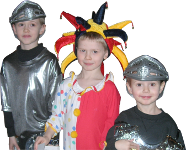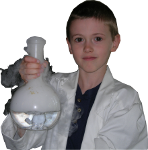Bubbles Unit Study
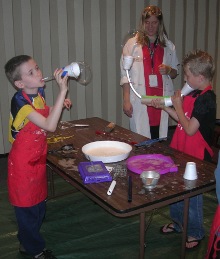 Bubbles have always fascinated me ever since I was a child. The rainbow-like spheres float through the air like magic. This is why I have played with bubbles with my children in many different ways. Some people call the study of bubbles bubbleology, but I prefer to call it bubblemania, since that describes a feeling rather than mere facts.
Bubbles have always fascinated me ever since I was a child. The rainbow-like spheres float through the air like magic. This is why I have played with bubbles with my children in many different ways. Some people call the study of bubbles bubbleology, but I prefer to call it bubblemania, since that describes a feeling rather than mere facts.
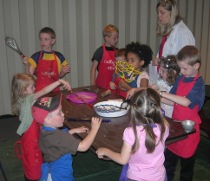 I suppose we should start with a good bubble recipe. Many abound on the internet, but the one I would recommend that works great with larger bubbles is the Klutz formula. This bubble solution includes 1 cup of Ultra Dawn dish soap, 12 cups of water, and one fourth of a cup of glycerine. (When I went to a pharmacy to buy the glycerin, the store clerk said she didn't have any. It wasn't until my husband looked in the stomach ailments section that we found it, contrary to what the silly clerk said.) Glycerine is not optional. The recipes that say “optional” are bonkers, since glycerine is what makes bubbles stronger and keeps them from popping before you're even finished blowing them up.
I suppose we should start with a good bubble recipe. Many abound on the internet, but the one I would recommend that works great with larger bubbles is the Klutz formula. This bubble solution includes 1 cup of Ultra Dawn dish soap, 12 cups of water, and one fourth of a cup of glycerine. (When I went to a pharmacy to buy the glycerin, the store clerk said she didn't have any. It wasn't until my husband looked in the stomach ailments section that we found it, contrary to what the silly clerk said.) Glycerine is not optional. The recipes that say “optional” are bonkers, since glycerine is what makes bubbles stronger and keeps them from popping before you're even finished blowing them up.
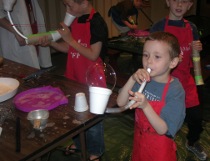 Stir the three ingredients gently, and you're ready to go. The Klutz book describes everything you would ever want to know about bubbles, including the fact that bubbles work better on a humid day. Indeed, once I invited another homeschooling family over for a morning of bubble activities years ago, only to find out that the air was too dry, so the bubbles popped immediately.
Stir the three ingredients gently, and you're ready to go. The Klutz book describes everything you would ever want to know about bubbles, including the fact that bubbles work better on a humid day. Indeed, once I invited another homeschooling family over for a morning of bubble activities years ago, only to find out that the air was too dry, so the bubbles popped immediately.
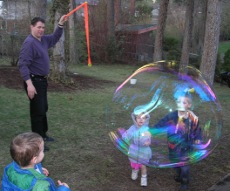 You can make huge bubbles in one of three ways. First, you can use the Klutz giant wand that comes with the Klutz book about bubbles. My husband used the huge wand (plastic poles with plastic strings) and created enormous bubbles successfully. The second way to create huge bubbles is to use a regular wand, and just blow gently for a long time. These bubbles won't be as big as the Klutz ones. Thirdly, you can use a hoola hoop in a child's wading pool. I saw this for the first time at a Children's Museum in Chicago, where a whole room was devoted to bubbles. A large circular tray stood in the middle of the room, where if you lifted the hoola hoop, you got a bubble tunnel going upwards. If a child is standing in the middle of a kiddie pool and you lift the hoola hoop around the child, suddenly the child is in a bubble tunnel. Someone made the pronouncement that you could put a child in a bubble, but unless you can find a way to seal the bubble on the top, it is a false claim, since the bubble is open at the top.
You can make huge bubbles in one of three ways. First, you can use the Klutz giant wand that comes with the Klutz book about bubbles. My husband used the huge wand (plastic poles with plastic strings) and created enormous bubbles successfully. The second way to create huge bubbles is to use a regular wand, and just blow gently for a long time. These bubbles won't be as big as the Klutz ones. Thirdly, you can use a hoola hoop in a child's wading pool. I saw this for the first time at a Children's Museum in Chicago, where a whole room was devoted to bubbles. A large circular tray stood in the middle of the room, where if you lifted the hoola hoop, you got a bubble tunnel going upwards. If a child is standing in the middle of a kiddie pool and you lift the hoola hoop around the child, suddenly the child is in a bubble tunnel. Someone made the pronouncement that you could put a child in a bubble, but unless you can find a way to seal the bubble on the top, it is a false claim, since the bubble is open at the top.
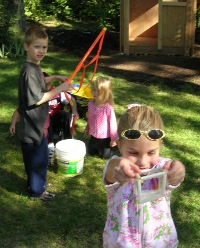 You can use all kinds of objects to blow bubbles with, including plastic strawberry containers, slotted spoons, straws, and funnels. You can also make a circle with your fingers and blow bubbles out of your hand. At a Children's Museum in Seattle, my children created their own bubble-makers out of clear bendy PVC pipe, plastic cups, packing tape, straws, and other plastic junk. The children who used paper products like toilet paper tubes or paper towel rolls soon regretted it, since the paper became mushy. Electrical tape or waterproof tape also works well to attach the fun kid bubble contraptions together. You can buy waterproof tape at a hardware store.
You can use all kinds of objects to blow bubbles with, including plastic strawberry containers, slotted spoons, straws, and funnels. You can also make a circle with your fingers and blow bubbles out of your hand. At a Children's Museum in Seattle, my children created their own bubble-makers out of clear bendy PVC pipe, plastic cups, packing tape, straws, and other plastic junk. The children who used paper products like toilet paper tubes or paper towel rolls soon regretted it, since the paper became mushy. Electrical tape or waterproof tape also works well to attach the fun kid bubble contraptions together. You can buy waterproof tape at a hardware store.
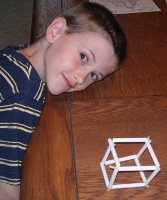 There are other machines that continuously pump out bubbles without any work on your part. They can be found at toy stores. These are especially helpful if you are having an “Under the Sea” birthday party. We have also gotten one of our sons a small bubble gun as a stocking stuffer one year. You dip the gun in bubble solution and press the trigger for continuous bubbles for a few seconds.
There are other machines that continuously pump out bubbles without any work on your part. They can be found at toy stores. These are especially helpful if you are having an “Under the Sea” birthday party. We have also gotten one of our sons a small bubble gun as a stocking stuffer one year. You dip the gun in bubble solution and press the trigger for continuous bubbles for a few seconds.
If you would like to make a bubble into a cube, you can cut 12 equal pieces of drinking straws. Then tie the cube together with string. Dip it into a bubble solution, and you have a bubble cube. Cool, huh?
For more great unit studies that will blow your socks off: Unit Study Treasure Vault.






